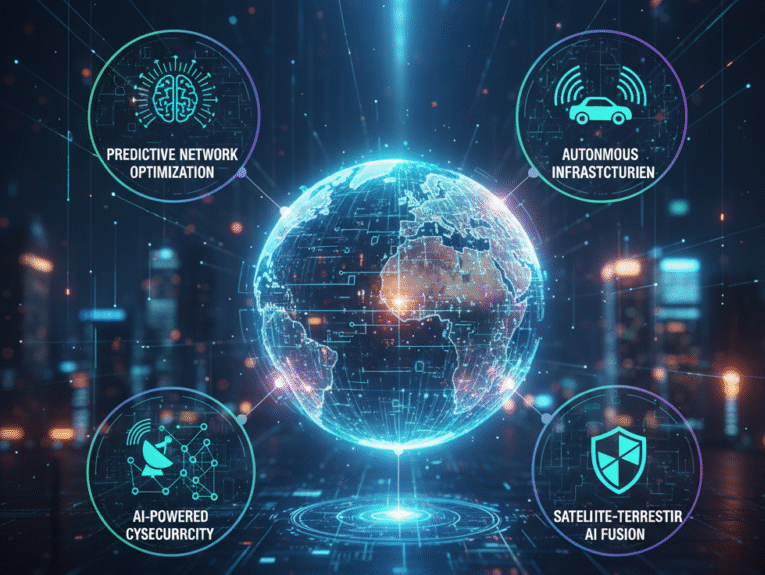In a world increasingly reliant on seamless connectivity, artificial intelligence is set to revolutionize the broadband sector. As we approach 2025, AI innovations promise faster, more reliable, and secure internet access worldwide, from urban hubs to remote areas. If you’re searching for “upcoming AI in broadband” or “AI technologies transforming global internet,” this guide explores the top advancements with in-depth explanations and real-world case studies. We’ll cover how AI enhances network efficiency, security, and accessibility, drawing from recent industry reports and trends.
AI-Driven Network Optimization: Boosting Efficiency and Reliability
AI is transforming broadband networks by predicting and managing traffic in real time, reducing downtime, and optimizing resource allocation. Machine learning algorithms analyze vast datasets from network devices to forecast peak usage, automate adjustments, and prevent bottlenecks. In 2025, expect AI to integrate deeply with fiber and wireless infrastructures, enabling self-healing networks that fix issues before they impact users. This shift not only cuts operational costs but also supports the growing demands of AI applications themselves, which require high-bandwidth connections.
Case Study: Ericsson’s AI Implementation in Telecom Networks
Ericsson has pioneered AI for network optimization, helping telecom operators like Vodafone reduce energy consumption by up to 15% through predictive analytics. In a European rollout, AI algorithms monitored traffic patterns and dynamically rerouted data, resulting in 20% faster response times during high-demand events. This case highlights how AI drives cost-effective buildouts, aligning with 2025 trends toward sustainable broadband expansion.
AI in 5G/6G and Net5.5G: Enabling Ultra-Fast Global Connectivity
As 5G matures and 6G emerges, AI plays a pivotal role in beamforming, spectrum management, and low-latency communications. Net5.5G, an evolutionary step toward 6G, leverages AI for intelligent routing and integration with satellite systems, ensuring seamless global coverage. By 2025, AI will optimize these networks for massive IoT deployments and enhanced mobile broadband, addressing challenges like rural connectivity.
Case Study: AT&T’s AI-Enhanced 5G Rollout
AT&T has utilized AI to accelerate 5G deployment, using machine learning for site planning and interference reduction. In a U.S. initiative, this led to a 30% improvement in signal quality in dense urban areas, supporting applications like remote healthcare. The project demonstrates AI’s potential in scaling next-gen networks globally, with similar efforts in Asia and Europe.
AI for Cybersecurity: Safeguarding the Global Internet Backbone
With cyber threats escalating, AI-powered tools detect anomalies, predict attacks, and automate responses in broadband networks. Upcoming advancements include generative AI for simulating threats and behavioral analysis to identify zero-day vulnerabilities. In 2025, expect AI to fortify critical infrastructure, especially as broadband supports AI data centers and cloud services.
Case Study: British Telecom’s AI Security Platform
British Telecom launched an AI-driven networking and security service, integrating threat intelligence to protect enterprise clients. In the UK public sector, it reduced breach incidents by 40% through real-time monitoring and automated firewalls. This example underscores AI’s role in maintaining trust in global internet ecosystems.
AI-Enhanced Edge Computing: Reducing Latency for Real-Time Applications
Edge computing pushes data processing closer to users, and AI amplifies this by enabling smart caching and predictive analytics at the network’s edge. In broadband, this means faster streaming, gaming, and AR/VR experiences worldwide. By 2025, AI will integrate with edge nodes to handle massive data from 5G devices, minimizing reliance on central clouds.
Case Study: Sand Technologies’ AI for Fiber Rollouts
Sand Technologies employed AI in edge computing to optimize fiber deployments for a major telecom provider, creating roadmaps that cut rollout times by 25%. The project enhanced edge performance in underserved regions, illustrating AI’s impact on global broadband equity.
AI in Satellite Broadband and FWA: Bridging the Digital Divide Globally
Low-Earth Orbit (LEO) satellites and Fixed Wireless Access (FWA) are expanding internet to remote areas, with AI optimizing orbits, signal routing, and bandwidth allocation. In 2025, AI will enhance systems like Starlink for dynamic weather adaptation and user prioritization.
Case Study: Hashgraph’s AI-Powered Internet on Hedera
Hashgraph Online is building an AI-driven decentralized internet on the Hedera network, using AI for efficient data distribution in satellite-linked setups. A $30K hackathon spurred innovations that improved connectivity in rural Asia, showcasing AI’s potential for affordable global access.
AI for Customer Experience and Personalization: Tailoring Broadband Services
AI chatbots, recommendation engines, and predictive tools are personalizing broadband plans, troubleshooting issues instantly, and forecasting user needs. Generative AI will dominate in 2025, offering customized content and support across global markets.
Case Study: Subex’s AI Forecasting in Telecom
Subex’s AI tools helped a leading provider predict customer churn and personalize packages, boosting retention by 18% in international markets. This approach exemplifies how AI fosters loyalty in the competitive broadband landscape.
Conclusion: The Future of AI-Powered Broadband Worldwide
As AI continues to evolve, its integration into the broadband industry will drive unprecedented global internet advancements in 2025. From optimizing networks to securing data and expanding access, these technologies promise a more connected planet. Stay ahead by exploring resources like Deloitte’s telecom outlooks or World Broadband Association reports. What AI broadband innovation excites you most? Share in the comments!


